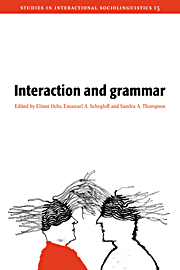Book contents
- Frontmatter
- Contents
- Notes on the contributors
- 1 Introduction
- 2 Turn organization: one intersection of grammar and interaction
- 3 Interactional units in conversation: syntactic, intonational, and pragmatic resources for the management of turns
- 4 Resources and repair: a cross-linguistic study of syntax and repair
- 5 On the “semi-permeable” character of grammatical units in conversation: conditional entry into the turn space of another speaker
- 6 On repeats and responses in Finnish conversations
- 7 “When I come down I'm in the domain state”: grammar and graphic representation in the interpretive activity of physicists
- 8 Transparent vision
- 9 Conversational signifying: grammar and indirectness among African American women
- 10 Creating evidence: making sense of written words in Bosavi
- Appendix Transcription conventions
- Index
6 - On repeats and responses in Finnish conversations
Published online by Cambridge University Press: 14 January 2010
- Frontmatter
- Contents
- Notes on the contributors
- 1 Introduction
- 2 Turn organization: one intersection of grammar and interaction
- 3 Interactional units in conversation: syntactic, intonational, and pragmatic resources for the management of turns
- 4 Resources and repair: a cross-linguistic study of syntax and repair
- 5 On the “semi-permeable” character of grammatical units in conversation: conditional entry into the turn space of another speaker
- 6 On repeats and responses in Finnish conversations
- 7 “When I come down I'm in the domain state”: grammar and graphic representation in the interpretive activity of physicists
- 8 Transparent vision
- 9 Conversational signifying: grammar and indirectness among African American women
- 10 Creating evidence: making sense of written words in Bosavi
- Appendix Transcription conventions
- Index
Summary
Introduction
Every language has conventionalized means for providing responses in talk-in-interaction. One set of these devices are particles, such as niin and joo in Finnish or yes in English. They are one-word linguistic expressions that have a potential for forming an utterance by themselves. These expressions are inherently indexical in their nature (on indexicality see, e.g. Silverstein, 1976; Heritage, 1984a; Ochs, 1988 and 1990). They point to their prior utterance which is prototypically produced by another speaker. By reference to that prior utterance, they offer an analysis of it. This analysis is being embedded in the action that they constitute. Furthermore, they are fitted to the trajectory of the larger activity and they participate in the progression of it. The response tokens, like other actions, are '“reflexive” in maintaining or altering the sense of the activities and unfolding circumstances in which they occur“ (Heritage, 1984a: 140). Their meaning is particularized by reference to the specific contexts of their use in which they are deployed in highly systematic ways for achieving particular interactional ends.
The purpose of this paper is to shed light on the meaning of response tokens by presenting initial observations on the particles niin and joo as constituting social actions in Finnish conversations. Niin and joo are among the most common response tokens in Finnish conversations. They have entered the field of Finnish discourse practices from different directions. Joo is a loan word from Swedish (Suomen sanojen alkuperä, s.v. joo) which has acquired its distinctive conventions of use in Finnish.
- Type
- Chapter
- Information
- Interaction and Grammar , pp. 277 - 327Publisher: Cambridge University PressPrint publication year: 1996
- 53
- Cited by



